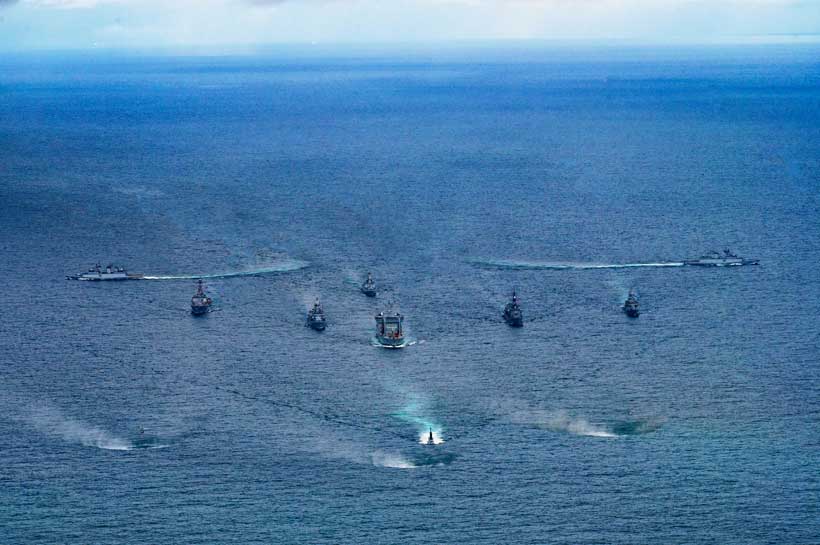The recently concluded multilateral maritime Malabar exercise among Quad countries (India, USA, Japan, and Australia) again comes up with a strong commitment to enhancing synergy, interoperability, and mutual cooperation to address the shared challenges of the Indo-Pacific region. The regular engagements of Quad countries at different platforms are a testament to their strong commitment towards promoting a free, open, transparent, inclusive, and rule-based Indo-Pacific region. Conversely, the increasing alignments of Delhi with Quad, particularly with Washington have different projections from Beijing’s side. Moreover, the growing geopolitical tensions between the two countries and Washington’s growing convergence in the Indo-Pacific region have made Delhi more vulnerable. Furthermore, considering the geographical proximity of Delhi and Beijing, the overall geopolitical environment between the two Asian giants has remained more confrontational. This informal strategic convergence of Delhi with the Quad countries has raised the question of strategic dilemma and trust deficit, particularly from the Beijing side.
Delhi and Quad’s Equation-
The increasing benevolent engagements of Quad grouping at different levels, viz ministerial and leaders, highlighted their growing partnership. In November 2020, when the Royal Navy of Australia joined the navies of India, Japan and the USA in the Malabar exercise, it depicted a distinct image of the Quad group which informally focused on the containment of Beijing in the Indian Ocean and Indo-Pacific region. An informal grouping of like-minded maritime democracies, anchored by strong shared values, upholds the international order based on the rule of law. The recent Quad leader summit at Wilmington has endorsed the strong commitment to expand the domain of Quad from merely maritime strategic dimensions to other essential aspects like economic, health, climate and clean energy cooperation in the Indo-Pacific region. In Delhi’s context, Quad has multifaceted dimensions, including strategic, economic and climatic dimensions. At the face of this, it is imperative to note that, next year when Delhi is going to organise the Quad Leader summit, how it will prioritise Indo-Pacific shared values by maintaining strategic balance with Beijing.
Delhi’s Strategic Predicament-
A group of shared values laid its cornerstone in the 2004 Indian Ocean Tsunami, where India, USA, Japan and Australia formed a coalition to mitigate the disaster impact, exemplified the coordination and cooperation through this event. Strategically, when the dynamics and landscapes of assertive Beijing became more threatening towards peace and stability of the Indo-Pacific region, it proactively gave rise to quadrilateral grouping to limit Beijing’s aggressive and expansionist rise. Moreover, in present times, the evolving geopolitical landscapes in South Asia and border skirmishes along the Line of Actual Control (LAC) have worsened the relations between the two Asian giants. Additionally, looking at Beijing’s military and economic superiority, it is evident that the containment of Delhi in the border area is not problematic for Beijing. Moreover, Beijing is quite familiar with the fact that Delhi will never ignite things on common grounds. Conversely, the greater alignment of Delhi towards the west can indeed hamper Delhi’s strategic establishment in the near future. Also, the growing closeness of Moscow, Islamabad, and Beijing remains Delhi’s biggest security concern. Even though Delhi can afford the convergence of Islamabad and Beijing, but it cannot afford the divergence of Moscow from Delhi, because of its growing closeness with Washington. The prolonged Russia-Ukraine war dynamics have also strengthened the bond between Moscow and Beijing, which widened the trust gap between Delhi and Moscow. Therefore, considering this complex geopolitical equation and direct land border connection, Delhi needs to be more cautious about the limit to which it needs to converge in this quadrilateral grouping.
Beijing’s View-
From Beijing’s lens, Quad always remains “Asian NATO”, considering its clear mandate regarding the containment of Beijing in the Indo-Pacific region. Amid increasing geopolitical rivalry and hegemonic race, the USA remains the biggest competitor for Beijing in the Indo-Pacific region. Beijing hardly sees Delhi as a potential competitor, but it could hamper Beijing’s interests if aligned with other Quad countries. Moreover, getting closer to Washington may provoke Beijing to take offensive action against Delhi in the border region. Although, Delhi has never formally or informally engaged with any kind of military pact with the USA, but its growing strategic engagement with Washington will hamper Chinese discourse in the South Asia and Indian Ocean region particularly. On one side, Beijing endorses Delhi’s non-alignment with Washington and contrarily, it always remains eager to make volatile behaviour with Delhi at the border region. Moreover, for Beijing, the strategic convergence of Quad has emerged as a consequential challenge to its ambitions in the near future.
Conclusion-
Delhi, the exponent of mutual cooperation, shared prosperity, and reciprocal gain, is ambitious to transform the Indo-Pacific region in a more amicable and deliberative manner. However, its strategic predicament against Beijing remains debatable. Considering the overall geopolitical environment between the two countries, and Delhi’s greater closeness towards the Quad, particularly with Washington, against the proximity of Beijing can hamper its national security in longer term. Therefore, the strategic balance between Quad and Beijing is categorically imperative for Delhi vis-a-vis its strategic environment and security dilemma.
